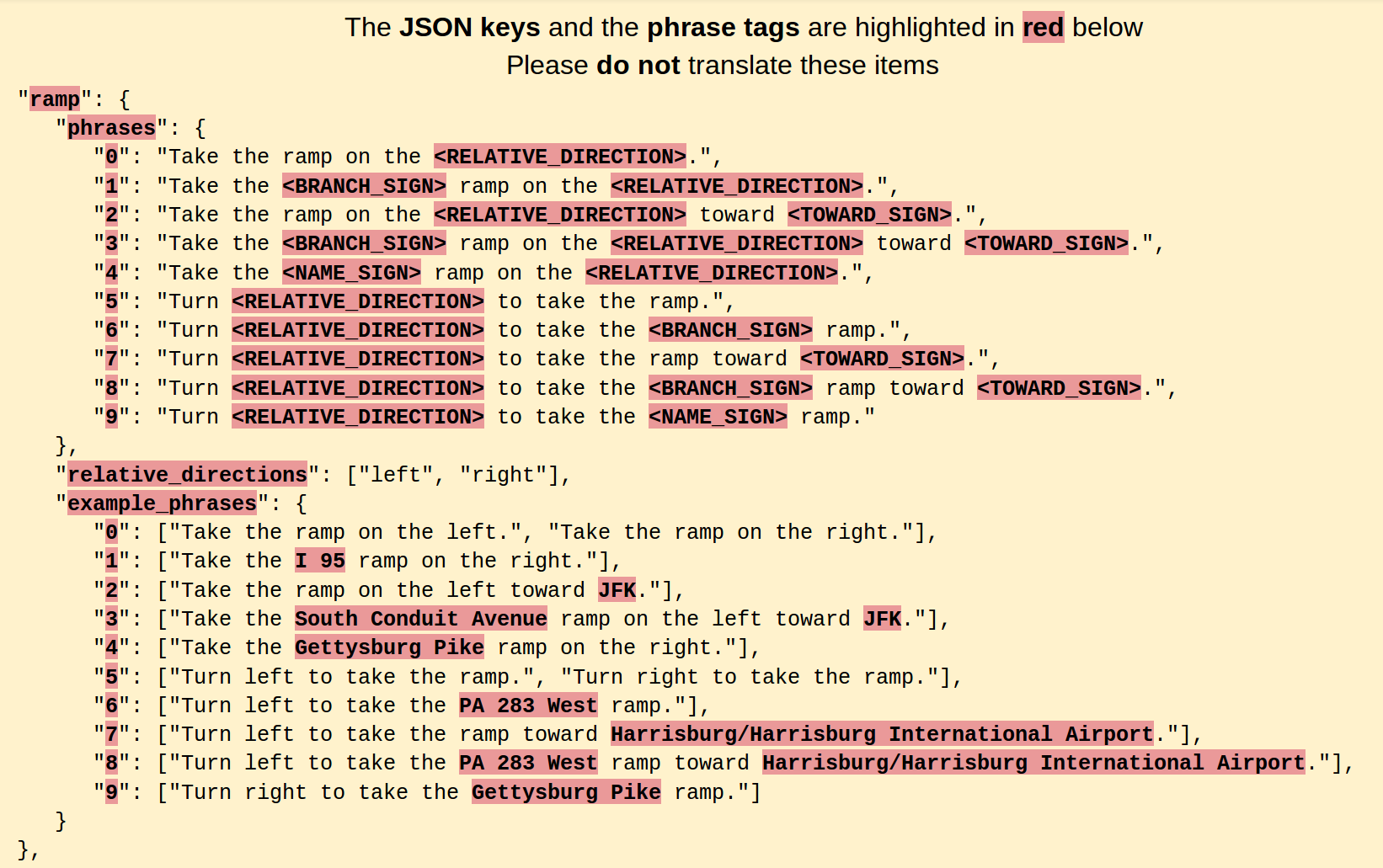Valhalla supports localized instructions in multiple languages for both textual and verbal phrases. All localized text is managed in JSON files in the locales directory. We rely on external contributors to provide translations of these phrases to other languages.
The recommended way to contribute translations is on Transifex. If you prefer you may also skip Transifex and edit the language files directly.
Follow these steps to start contributing a translation:
- Sign up for a free account at https://www.transifex.com/.
- Navigate to https://www.transifex.com/explore/projects/ and search for the
Valhalla Phrasesproject. - Submit a request to join the team for the languages you know. You may also request a new language if yours does not appear in the list.
- Wait for an email with an invitation to start translating.
- From the dashboard, navigate to the Translate page for your chosen language.
- Select the
en-US.jsonsource file to translate from. - Before you start translating make sure to filter out any phrases with the
notranslatetag. Apply this filter by selecting Tag > Doesn't contain tag > notranslate. - For more information on how to use Transifex, check out the getting started guide.
Once a language is 100% translated, the project maintainers will be notified and we will make a PR with your updates. Thank you for your contribution!
Follow these instructions if you prefer to edit the JSON files directly without Transifex.
-
Copy the en-US.json to
<NEW_LANGUAGE_TAG>.jsonUsing IETF BCP 47 as reference - the typical format for the<NEW_LANGUAGE_TAG>is: <ISO 639 two-letter language code>-<ISO 3166 two-letter country code> Czech/Czech Republic example:cs-CZ -
Update the
posix_localevalue in your new file. The character encoding must be UTF-8. The typical format is: <ISO 639 two-letter language code>_<ISO 3166 two-letter country code>.UTF-8 Czech/Czech Republicposix_localeexample:cs_CZ.UTF-8 -
Update the
aliasesarray in your new file. A typical alias entry is the ISO 639 two-letter language code without the ISO 3166 two-letter country code. The alias entry must be unique across language files. Czechaliasesentry example:cs -
Do not translate the JSON keys or phrase tags. An example using the ramp instruction:

-
Please translate the JSON values. As needed, reorder the phrase words and tags - the tags must remain in the phrase. An example using the ramp instruction:

-
Run
make checkto verify the tests pass OR move on to step#7 and we can help verify. -
Submit a pull request for review. Thank you!
-
First add the new strings in en-US.json. The JSON keys are used by narrative_builder to select the instruction template string.
-
Sync the new strings to each new narrative language file by running
./merge-en.sh. This will copy the new English strings to each new language. -
Update the English strings in each language file.
TODO
TODO
Use the Transifex command line client, tx, to sync locale files with the Transifex website.
- Install tx.
- Get an API secret from your settings page.
- Run
tx statusin the root valhalla directory to confirm.
These were the steps taken to setup tx for the first time, you can probably just skip to the next section.
- Run
tx initin the root directory. This will walk you through creating the.tx/configfile. - Use
locales/en-US.jsonas the path to the source file. - Use
locales/<lang>.jsonas the path to the translation files. - Use
Valhallaas the Organization name andValhalla Phrasesas the project name.
To learn more about the Config command, visit https://docs.transifex.com/client/config.
Use this command to pull all changes from Transifex into the Valhalla repo.
tx pull --all
Or for just one language (use --force to overwrite local):
tx pull --language <lang> --force
When the source file en-US.json has been updated on Transifex manually.
tx pull --source
When edits have been made to the locale JSON files manually in git but not in Transifex.
NOTE: this command will overwrite the file on Transifex, you will want to pull updates first and resolve any conflicts.
tx pull --all
# resolve conflicts, open PR
tx push --all
Translation files for new languages that are contributed in Transifex are not automatically downloaded by tx. Use the --language flag to force download the new file and PR it to Valhalla.
tx pull --language <lang> --force
Warning: By using --force, the uploaded files will overwrite remote translations, even if they are newer than your uploaded files.
New language files added in Valhalla need to be uploaded to Transifex for external contributors to make updates in the translation interface. Make sure that language does not already have a translation file in Transifex first by trying a pull command.
tx pull --language <lang>
# if no translation exists push up a new one
tx push --language <lang> --translations